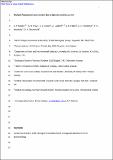Files in this item
Multiple Palaeoproterozoic carbon burial episodes and excursions
Item metadata
| dc.contributor.author | Martin, A.P. | |
| dc.contributor.author | Prave, A.R. | |
| dc.contributor.author | Condon, D.J. | |
| dc.contributor.author | Lepland, A. | |
| dc.contributor.author | Fallick, A.E. | |
| dc.contributor.author | Romashkin, A.E. | |
| dc.contributor.author | Medvedev, P.V. | |
| dc.contributor.author | Rychanchik, D.V. | |
| dc.date.accessioned | 2016-06-02T23:32:45Z | |
| dc.date.available | 2016-06-02T23:32:45Z | |
| dc.date.issued | 2015-08-15 | |
| dc.identifier | 194583740 | |
| dc.identifier | 04b1b6f4-3883-4f7a-b142-b80386f3e1aa | |
| dc.identifier | 84937911584 | |
| dc.identifier | 000357223300021 | |
| dc.identifier.citation | Martin , A P , Prave , A R , Condon , D J , Lepland , A , Fallick , A E , Romashkin , A E , Medvedev , P V & Rychanchik , D V 2015 , ' Multiple Palaeoproterozoic carbon burial episodes and excursions ' , Earth and Planetary Science Letters , vol. 424 , pp. 226-236 . https://doi.org/10.1016/j.epsl.2015.05.023 | en |
| dc.identifier.issn | 0012-821X | |
| dc.identifier.other | RIS: urn:B66E6D8DEB8555F273F795DD19B4261C | |
| dc.identifier.other | ORCID: /0000-0002-4614-3774/work/64033715 | |
| dc.identifier.uri | https://hdl.handle.net/10023/8922 | |
| dc.description | APM, DJC, ARP and AEF were supported by NERC grant NE/G00398X/1. | en |
| dc.description.abstract | Organic-rich rocks (averaging 2–5% total organic carbon) and positive carbonate-carbon isotope excursions (δ13C > 5‰ and locally much higher, i.e. the Lomagundi-Jatuli Event) are hallmark features of Palaeoproterozoic successions and are assumed to archive a global event of unique environmental conditions following the c. 2.3 Ga Great Oxidation Event. Here we combine new and published geochronology that shows that the main Palaeoproterozoic carbon burial episodes (CBEs) preserved in Russia, Gabon and Australia were temporally discrete depositional events between c. 2.10 and 1.85 Ga. In northwest Russia we can also show that timing of the termination of the Lomagundi-Jatuli Event may have differed by up to 50 Ma between localities, and that Ni mineralisation occurred at c. 1920 Ma. Further, CBEs have traits in common with Mesozoic Oceanic Anoxic Events (OAEs); both are exceptionally organic-rich relative to encasing strata, associated with contemporaneous igneous activity and marked by organic carbon isotope profiles that exhibit a stepped decrease followed by a stabilisation period and recovery. Although CBE strata are thicker and of greater duration than OAEs (100 s of metres versus metres, ∼106 years versus ∼105 years), their shared characteristics hint at a commonality of cause(s) and feedbacks. This suggests that CBEs represent processes that can be either basin-specific or global in nature and a combination of circumstances that are not unique to the Palaeoproterozoic. Our findings urge circumspection and re-consideration of models that assume CBEs are a Deep Time singularity. | |
| dc.format.extent | 11 | |
| dc.format.extent | 1012075 | |
| dc.language.iso | eng | |
| dc.relation.ispartof | Earth and Planetary Science Letters | en |
| dc.subject | Carbon burial event | en |
| dc.subject | GOE | en |
| dc.subject | Shunga-Francevillian Event | en |
| dc.subject | Lomagundi-Jatuli Event | en |
| dc.subject | U–Pb geochronology | en |
| dc.subject | GB Physical geography | en |
| dc.subject | GE Environmental Sciences | en |
| dc.subject | NDAS | en |
| dc.subject | BDC | en |
| dc.subject.lcc | GB | en |
| dc.subject.lcc | GE | en |
| dc.title | Multiple Palaeoproterozoic carbon burial episodes and excursions | en |
| dc.type | Journal article | en |
| dc.contributor.sponsor | NERC | en |
| dc.contributor.institution | University of St Andrews. School of Earth & Environmental Sciences | en |
| dc.contributor.institution | University of St Andrews. Marine Alliance for Science & Technology Scotland | en |
| dc.contributor.institution | University of St Andrews. Scottish Oceans Institute | en |
| dc.contributor.institution | University of St Andrews. St Andrews Sustainability Institute | en |
| dc.contributor.institution | University of St Andrews. St Andrews Isotope Geochemistry | en |
| dc.contributor.institution | University of St Andrews. Earth and Environmental Sciences | en |
| dc.identifier.doi | 10.1016/j.epsl.2015.05.023 | |
| dc.description.status | Peer reviewed | en |
| dc.date.embargoedUntil | 2016-06-03 | |
| dc.identifier.url | https://www.sciencedirect.com/science/article/pii/S0012821X15003131#se0400 | en |
| dc.identifier.grantnumber | NE/G004285/1 | en |
This item appears in the following Collection(s)
Items in the St Andrews Research Repository are protected by copyright, with all rights reserved, unless otherwise indicated.

